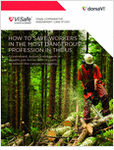 | With a rate of workplace fatalities 30 times higher than the national average, logging is the most dangerous profession in the U.S., including the military. This is reflected in the costs of insurance; loggers in Washington State pay premiums that range between $6.51 and $26.94 per hour. But for all the dangers of traumatic or lethal injury, there is something that is not so much a risk as a given outcome. Almost 100% of all long-term loggers sustain such severe musculoskeletal disorders (MSDs) that they result in a career change before the age of 50. By a wide margin, MSDs represent the largest percentage of compensable occupational claims in the logging industry. Of course, for the foreseeable future, logging will remain a tough job; the real question is how to make all this physical activity build, rather than break, the body. But how do you analyze and improve movement patterns when you’re as far as you can possibly get from a biomechanics lab? Read how the use of dorsaVi's workplace wearable sensor solution was able to provide insights into how improvements could be made. Request Free! |
